互动式教学Interactive Learning
多媒体技术在初中英语教学中的应用
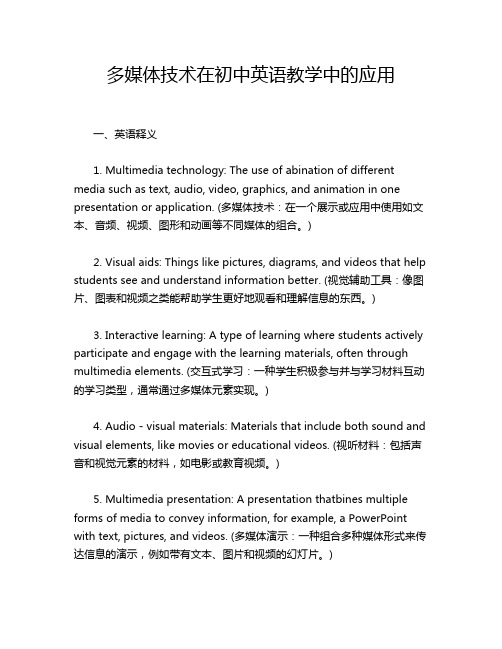
多媒体技术在初中英语教学中的应用一、英语释义1. Multimedia technology: The use of abination of different media such as text, audio, video, graphics, and animation in one presentation or application. (多媒体技术:在一个展示或应用中使用如文本、音频、视频、图形和动画等不同媒体的组合。
)2. Visual aids: Things like pictures, diagrams, and videos that help students see and understand information better. (视觉辅助工具:像图片、图表和视频之类能帮助学生更好地观看和理解信息的东西。
)3. Interactive learning: A type of learning where students actively participate and engage with the learning materials, often through multimedia elements. (交互式学习:一种学生积极参与并与学习材料互动的学习类型,通常通过多媒体元素实现。
)4. Audio - visual materials: Materials that include both sound and visual elements, like movies or educational videos. (视听材料:包括声音和视觉元素的材料,如电影或教育视频。
)5. Multimedia presentation: A presentation thatbines multiple forms of media to convey information, for example, a PowerPoint with text, pictures, and videos. (多媒体演示:一种组合多种媒体形式来传达信息的演示,例如带有文本、图片和视频的幻灯片。
英语教学中的互动教学模式

英语教学中的互动教学模式Interactive teaching modes in English teaching。
互动教学模式是指教学者与学习者之间的双向交流和互相配合,学生通过活跃参与,激发兴趣,增强记忆,在交流中达到知识的掌握和技能的提高。
英语教学中,互动教学模式能够有效地激发学生的学习兴趣,培养学生的英语交际能力,提高学习效率。
以下是几种英语教学中的互动教学模式:1.小组讨论模式:为了激发学生的学习积极性,老师可以将学生分成小组,让他们在小组当中进行讨论。
在讨论过程中,老师应该根据学生不同的水平,帮助学生理解语言知识,并引导学生探讨问题,发表观点,加深对知识的理解与记忆。
Group discussion mode: To stimulate students' learning enthusiasm, teachers can divide students into small groups and let them discuss in the group. In the process of discussion, the teacher should help students understand language knowledge according to their different levels, guide students to explore problems, express their opinions, and deepen their understanding and memory of knowledge.2.角色扮演模式:角色扮演是互动教学中的一种有效的教学方法。
在英语教学中,教师可以通过角色扮演,让学生在真实的场景中,运用所学的英语知识进行交流,从而增强英语口语表达能力。
同时,角色扮演也能够促进学生与教师之间的互动交流。
3.游戏模式:在英语教学中,通过游戏模式能够更好地吸引学生的注意力,增强学习兴趣。
幼儿英语教师资格证

幼儿英语教师资格证以下是20个幼儿英语教师资格证相关的单词、短语,并包含英语释义、用法及双语例句:一、单词1. Kindergarten- 英语释义:a school or class for young children, usually between the ages of three and five.- 用法:作名词,可单独使用表示“幼儿园”这一概念。
- 双语例句:- The little boy goes to kindergarten every day. (这个小男孩每天去幼儿园。
)- There are many toys in the kindergarten. (幼儿园里有很多玩具。
)2. Teacher- 英语释义:a person who teaches, especially in a school.- 用法:作名词,可指各种教育阶段的教师。
- 双语例句:- My English teacher is very kind. (我的英语老师非常和蔼。
) - The teacher is teaching the children how to sing. (老师正在教孩子们如何唱歌。
)3. Child (复数形式:children)- 英语释义:a young human being below the age of puberty or below the legal age of majority.- 用法:作名词,“child”为单数,“children”为复数形式,用来指儿童。
- 双语例句:- This child likes to draw pictures. (这个孩子喜欢画画。
)- There are many children in the park. (公园里有很多孩子。
)4. Learn- 英语释义:gain or acquire knowledge of or skill in (something) by study, experience, or being taught.- 用法:作动词,可接名词、代词或不定式作宾语。
初中英语互动式课堂教学模式的与分析
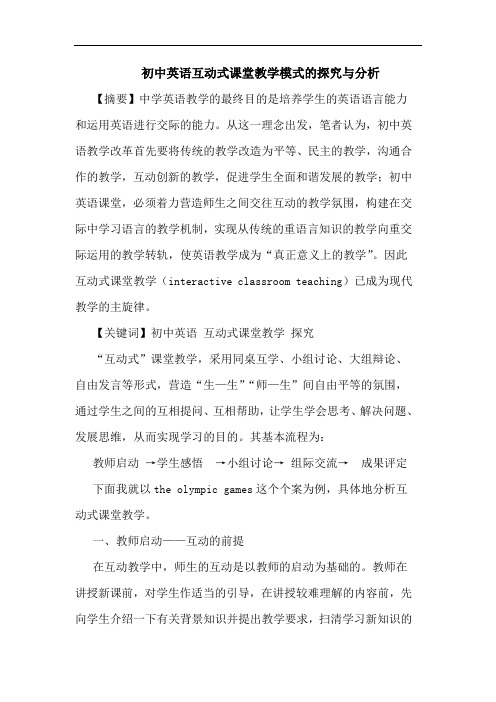
初中英语互动式课堂教学模式的探究与分析【摘要】中学英语教学的最终目的是培养学生的英语语言能力和运用英语进行交际的能力。
从这一理念出发,笔者认为,初中英语教学改革首先要将传统的教学改造为平等、民主的教学,沟通合作的教学,互动创新的教学,促进学生全面和谐发展的教学;初中英语课堂,必须着力营造师生之间交往互动的教学氛围,构建在交际中学习语言的教学机制,实现从传统的重语言知识的教学向重交际运用的教学转轨,使英语教学成为“真正意义上的教学”。
因此互动式课堂教学(interactive classroom teaching)已成为现代教学的主旋律。
【关键词】初中英语互动式课堂教学探究“互动式”课堂教学,采用同桌互学、小组讨论、大组辩论、自由发言等形式,营造“生—生”“师—生”间自由平等的氛围,通过学生之间的互相提问、互相帮助,让学生学会思考、解决问题、发展思维,从而实现学习的目的。
其基本流程为:教师启动→学生感悟→小组讨论→组际交流→成果评定下面我就以the olympic games这个个案为例,具体地分析互动式课堂教学。
一、教师启动——互动的前提在互动教学中,师生的互动是以教师的启动为基础的。
教师在讲授新课前,对学生作适当的引导,在讲授较难理解的内容前,先向学生介绍一下有关背景知识并提出教学要求,扫清学习新知识的障碍,为学习新课提供丰富的感性材料,为学生的理解打下良好的基础。
同时为学生营造良好的语言环境和提供充分的语言实践和语言交际的机会。
教师的启动可放在课前,也可放在课外。
如在《the olympic games》的课堂教学前,先布置学生查找奥运会的相关知识,鼓励学生利用教育信息资源(图书馆、互联网等)查找学习材料进行阅读、交流、整理。
完成了开放式的课前预习活动后,在呈现新的语言材料之前,我设计了一个“猜词秀”的语言游戏,一个同学看老师给他的单词,用英语描述给他的组内同伴,同伴根据他的描述猜出单词。
该游戏主要是热身,使学生熟悉体育运动中的重要词汇(athlete, stadium, wrestling, medal, competitor,etc)这些词汇就好像是一个有关运动的“词汇信息包”,通过运用,学生在不知不觉中就耳熟能详了。
拼音教学方法
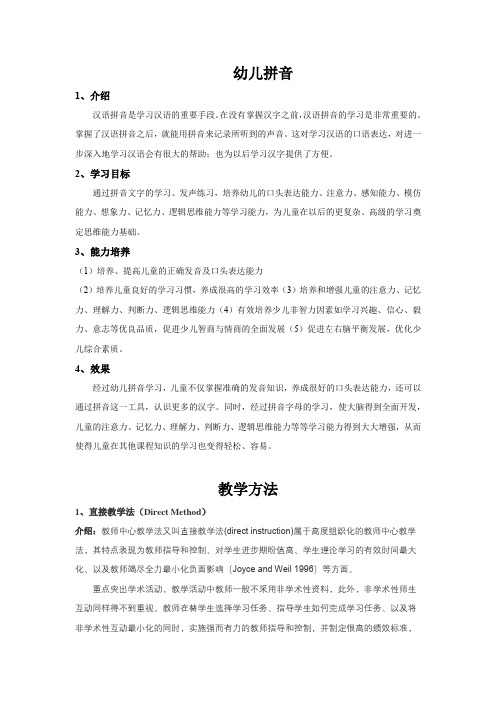
幼儿拼音1、介绍汉语拼音是学习汉语的重要手段。
在没有掌握汉字之前,汉语拼音的学习是非常重要的。
掌握了汉语拼音之后,就能用拼音来记录所听到的声音。
这对学习汉语的口语表达,对进一步深入地学习汉语会有很大的帮助;也为以后学习汉字提供了方便。
2、学习目标通过拼音文字的学习、发声练习,培养幼儿的口头表达能力、注意力、感知能力、模仿能力、想象力、记忆力、逻辑思维能力等学习能力,为儿童在以后的更复杂、高级的学习奠定思维能力基础。
3、能力培养(1)培养、提高儿童的正确发音及口头表达能力(2)培养儿童良好的学习习惯,养成很高的学习效率(3)培养和增强儿童的注意力、记忆力、理解力、判断力、逻辑思维能力(4)有效培养少儿非智力因素如学习兴趣、信心、毅力、意志等优良品质,促进少儿智商与情商的全面发展(5)促进左右脑平衡发展,优化少儿综合素质。
4、效果经过幼儿拼音学习,儿童不仅掌握准确的发音知识,养成很好的口头表达能力,还可以通过拼音这一工具,认识更多的汉字。
同时,经过拼音字母的学习,使大脑得到全面开发,儿童的注意力、记忆力、理解力、判断力、逻辑思维能力等等学习能力得到大大增强,从而使得儿童在其他课程知识的学习也变得轻松、容易。
教学方法1、直接教学法(Direct Method)介绍:教师中心教学法又叫直接教学法(direct instruction)属于高度组织化的教师中心教学法,其特点表现为教师指导和控制、对学生进步期盼值高、学生理论学习的有效时间最大化、以及教师竭尽全力最小化负面影响(Joyce and Weil 1996)等方面。
重点突出学术活动,教学活动中教师一般不采用非学术性资料,此外,非学术性师生互动同样得不到重视。
教师在替学生选择学习任务、指导学生如何完成学习任务、以及将非学术性互动最小化的同时,实施强而有力的教师指导和控制,并制定很高的绩效标准,要求学生达到境界。
如我国多数高校的大学英语教学过程中,绝大部分教师依然将教学目标锁定在等级考试上,一切教学活动都以大学英语四六级过级为核心。
iuv课件

智能制造探索方向包括生产过程智能 化、装备智能化、产品智能化等方面 ,具体涉及物联网、大数据分析、云 计算等技术的应用。
要点三
智能制造探索案例
海尔集团智能制造转型实践、苏州工 业园区智能制造基地建设等。
案例四:智能农业示范
01
02
智能农业概述
智能农业应用场景
智能农业是指借助现代信息技术,通 过对传统农业生产进行数字化和智能 化改造,提高农业生产效率、农产品 质量和农民收益。
iuv产业生态展望
技术生态构建
IUV课件将构建完善的技术生态圈,包括技术研发、产品应用、产业协作等多个 环节,推动整个行业的创新发展。
商业模式创新
IUV课件也将探索更加创新的商业模式,如平台化运营、个性化定制等,以适应 不断变化的市场需求。
THANKS
感谢观看
和产品质量。
智能质检
iuv通过图像识别和深度学习等技 术,实现产品外观和质量检测, 提高生产质量。
智能物流
iuv监测物料和半成品的库存情况 ,实现物料和半成品自动补货,提 高生产协同效率。
智能农业
智慧温室
iuv监测大棚内的温度、湿度、 光照等环境参数,实现自动化 控制和调节,提高农作物生长
和生产效益。
iuv课件
xx年xx月xx日
目 录
• iuv简介 • iuv基础知识 • iuv应用场景 • iuv实践案例 • iuv未来展望
01
iuv简介
iuv是什么
IUV(Interactive Learning Platform)是一种基于互联网和 云计算技术的互动式学习平台,旨在为学生提供个性化的、 多样化的、自主选择的学习体验。 析等方面,具体涉及物联网、云计算 、人工智能等技术的应用。
新课程理念下的互动式英语课堂教学
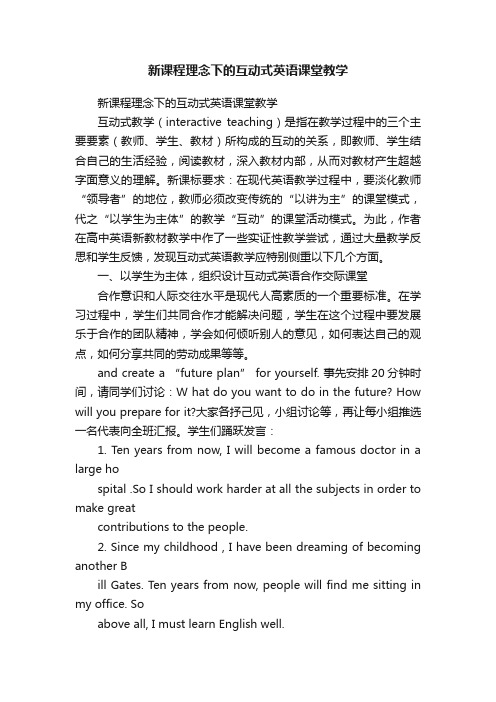
新课程理念下的互动式英语课堂教学新课程理念下的互动式英语课堂教学互动式教学(interactive teaching)是指在教学过程中的三个主要要素(教师、学生、教材)所构成的互动的关系,即教师、学生结合自己的生活经验,阅读教材,深入教材内部,从而对教材产生超越字面意义的理解。
新课标要求:在现代英语教学过程中,要淡化教师“领导者”的地位,教师必须改变传统的“以讲为主”的课堂模式,代之“以学生为主体”的教学“互动”的课堂活动模式。
为此,作者在高中英语新教材教学中作了一些实证性教学尝试,通过大量教学反思和学生反馈,发现互动式英语教学应特别侧重以下几个方面。
一、以学生为主体,组织设计互动式英语合作交际课堂合作意识和人际交往水平是现代人高素质的一个重要标准。
在学习过程中,学生们共同合作才能解决问题,学生在这个过程中要发展乐于合作的团队精神,学会如何倾听别人的意见,如何表达自己的观点,如何分享共同的劳动成果等等。
and create a “future plan” for yourself. 事先安排20分钟时间,请同学们讨论:W hat do you want to do in the future? How will you prepare for it?大家各抒己见,小组讨论等,再让每小组推选一名代表向全班汇报。
学生们踊跃发言:1. Ten years from now, I will become a famous doctor in a large hospital .So I should work harder at all the subjects in order to make greatcontributions to the people.2. Since my childhood , I have been dreaming of becoming another Bill Gates. Ten years from now, people will find me sitting in my office. Soabove all, I must learn English well.3. I will be a successful chemist ten years from now. In order todevote myself to protecting the environment around us , I must have a goodknowledge of chemistry and other subjects.4. Ten years from now, I will be able to receive a doctor’s degreefrom Oxford University. In order to make my dream come true, I’ll try mybest to learn English well.学生表现如此出色,这正是他们相互交流,相互合作,取长补短的收获,是集体智慧的结晶。
互动式英语教学法在英语课堂中的应用

互动式英语教学法在英语课堂中的应用【摘要】本文介绍了互动式英语教学法在英语课堂中的重要性,并概述了本文的主要内容。
在讨论了互动式教学法如何提高学生参与度,促进学生口语表达能力的提升,激发学生学习兴趣,提升教学效果以及丰富课堂教学方式。
结论部分总结了互动式英语教学法的优点,并展望了其在未来的应用前景。
通过本文的阐述,读者可以深入了解互动式英语教学法的重要性及优势,以及如何有效应用于英语课堂教学中,提升学生的学习效果和积极性。
【关键词】互动式英语教学法、学生参与度、口语表达能力、学习兴趣、教学效果、课堂教学方式、优点、未来应用。
1. 引言1.1 介绍互动式英语教学法在英语课堂中的重要性Interactive English teaching method is a crucial approach in modern English language education. It plays a significant role in enhancing student engagement, promoting oral expression skills, stimulating learning interest, improving teaching effectiveness, and diversifying classroom teaching methods. The importance of interactive English teaching method lies in its ability to create adynamic and engaging learning environment, where students actively participate in discussions, group activities, and interactive exercises. This not only helps students to develop their language skills but also fosters critical thinking, collaboration, and communication skills.1.2 概述本文的主要内容这篇文章将探讨互动式英语教学法在英语课堂中的重要性。
中学数学课的互动式教学
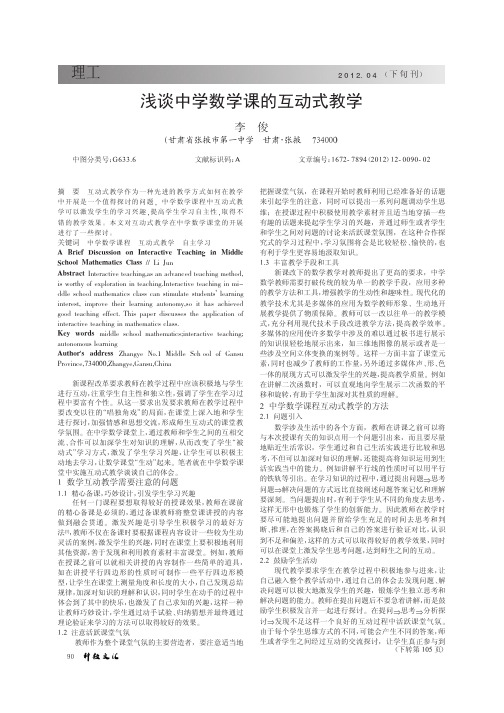
(下转第105页)摘要互动式教学作为一种先进的教学方式如何在教学中开展是一个值得探讨的问题,中学数学课程中互动式教学可以激发学生的学习兴趣,提高学生学习自主性,取得不错的教学效果。
本文对互动式教学在中学数学课堂的开展进行了一些探讨。
关键词中学数学课程互动式教学自主学习A Brief Discussion on Interactive Teaching in Middle School Mathematics Class //Li JunAbstract Interactive teaching,as an advanced teaching method,is worthy of exploration in teaching.Interactive teaching in mi-ddle school mathematics class can stimulate students 'learning interest,improve their learning autonomy,so it has achieved good teaching effect.This paper discusses the application of interactive teaching in mathematics class.Key words middle school mathematics;interactive teaching;autonomous learningAuthor 's address Zhangye No.1Middle Sch ool of Gansu Province,734000,Zhangye,Gansu,China新课程改革要求教师在教学过程中应该积极地与学生进行互动,注重学生自主性和独立性,强调了学生在学习过程中要富有个性。
从这一要求出发要求教师在教学过程中要改变以往的“唱独角戏”的局面,在课堂上深入地和学生进行探讨,加强情感和思想交流,形成师生互动式的课堂教学氛围。
高中英语课堂互动教学模式的运用
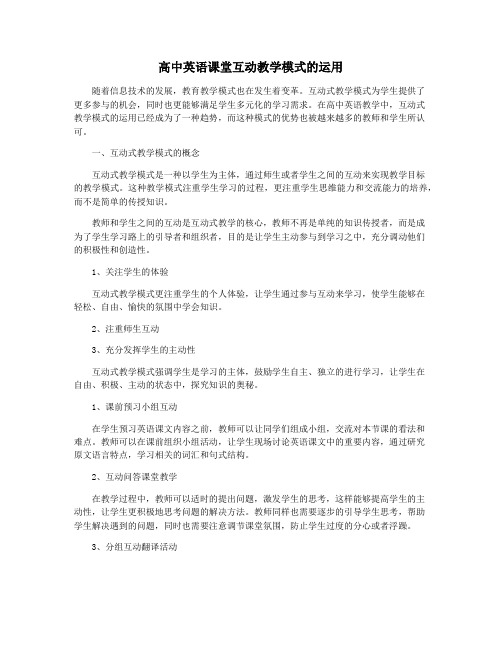
高中英语课堂互动教学模式的运用随着信息技术的发展,教育教学模式也在发生着变革。
互动式教学模式为学生提供了更多参与的机会,同时也更能够满足学生多元化的学习需求。
在高中英语教学中,互动式教学模式的运用已经成为了一种趋势,而这种模式的优势也被越来越多的教师和学生所认可。
一、互动式教学模式的概念互动式教学模式是一种以学生为主体,通过师生或者学生之间的互动来实现教学目标的教学模式。
这种教学模式注重学生学习的过程,更注重学生思维能力和交流能力的培养,而不是简单的传授知识。
教师和学生之间的互动是互动式教学的核心,教师不再是单纯的知识传授者,而是成为了学生学习路上的引导者和组织者,目的是让学生主动参与到学习之中,充分调动他们的积极性和创造性。
1、关注学生的体验互动式教学模式更注重学生的个人体验,让学生通过参与互动来学习,使学生能够在轻松、自由、愉快的氛围中学会知识。
2、注重师生互动3、充分发挥学生的主动性互动式教学模式强调学生是学习的主体,鼓励学生自主、独立的进行学习,让学生在自由、积极、主动的状态中,探究知识的奥秘。
1、课前预习小组互动在学生预习英语课文内容之前,教师可以让同学们组成小组,交流对本节课的看法和难点。
教师可以在课前组织小组活动,让学生现场讨论英语课文中的重要内容,通过研究原文语言特点,学习相关的词汇和句式结构。
2、互动问答课堂教学在教学过程中,教师可以适时的提出问题,激发学生的思考,这样能够提高学生的主动性,让学生更积极地思考问题的解决方法。
教师同样也需要逐步的引导学生思考,帮助学生解决遇到的问题,同时也需要注意调节课堂氛围,防止学生过度的分心或者浮躁。
3、分组互动翻译活动在分组活动中,教师可以将学生分成几个小组,每个小组负责翻译一些英语新闻、文章或者其他英语素材。
通过组间互动协商,学生会更积极的思考问题解决方案,充分调动学生的主动性和创造性。
4、互动讨论与解读在阅读英语故事和文章的过程中,教师可以安排同学们进行小组互动,帮助学生进行交流和讨论。
浅谈互动式高中英语课堂教学

浅谈互动式高中英语课堂教学铜梁中学校陈英摘要:在英语教学中,处理好教师、学生及教材之间的相互关系,合理利用多媒体,开展课堂的师生、生生、学生与教材、小组与小组之间的互动活动,创设课堂情景,活跃课堂氛围,让学生自己动手查阅资料,提问解疑,分享成果,扩大课堂空间,丰富英语内涵,学生就能提高英语学习的兴趣、口语表达能力、英语的主动探讨学习能力以及英语整体水平的能力。
关键词:课堂互动提高高中英语新教材特点是词汇量大,知识面广,课文材料贴近现实生活,对学生运用英语语言的能力要求更高。
而学生越学越感困难,少部分学生甚至不学。
为此,我在培养创造性思维教学方面不断摸索,设法逐步摆脱呆板陈旧的说教式教学方法,充分用好课堂40分钟,在课堂上运用互动式英语教学,激励学生好奇地问,自信地说。
让学生在动手、动口、动脑中发展思维,更多地了解英语知识及英美文化史,从而让学生更好地学好英语。
什么是互动式教学(interactive teaching)?互动式教学是指在教学过程中的三个主要要素(教师、学生、教材)所构成的互动的关系,即教师、学生结合自己的生活经验,阅读教材,深入教材内部,与教材对话交流,从而对教材产生超越字面意义的理解。
然后,通过教师与学生对话、学生与学生对话,将“理解”汇拢、交流,这样既对教材进行修正、补充和丰富,也使教师、学生群体、学生个体在对彼此“理解”反思的基础上,加深对教材的理解,提高阅读能力,在现代的英语教学过程中,教师必须改变传统的“听讲为主”的课堂模式,代之“以学生为主体”的教学“互动”的课堂教学模式。
笔者主要从以下几方面来实施互动教学的。
一、合理利用多媒体,激发英语学习兴趣,产生强烈的互动欲望。
把多媒体技术引入学校英语教学课堂,可以极大地丰富教学内容,提供足够的听力材料和对话情景,给英语课堂教学带来高效、逼真的语言学习环境,使枯燥抽象的英语学习内容变得富于趣味和吸引力,使英语教学形式多元化,以此激发学生英语学习的强烈愿望和自主性,也会让学生自己要学英语、爱学英语,最终学好英语。
互动式教学模式在高中英语教学中的实践

互动式教学模式在高中英语教学中的实践随着教育教学领域的不断发展,互动式教学模式在高中英语教学中的应用越来越受到重视。
与传统的单向传授知识不同,互动式教学模式强调教师和学生的互动,倡导学生参与式学习,通过讨论、互动、合作等形式,激发学生的学习兴趣,提高学习效果。
本文将探讨互动式教学模式在高中英语教学中的实践方案,以及该模式的优势和挑战。
一、互动式教学模式的实践方案1. 知识导入在教学开始阶段,教师可以通过提出问题、讲述趣闻或者展示图片等方式引发学生的兴趣,让学生主动参与到课堂中来。
2. 小组合作将学生分成小组,通过小组合作的方式,让学生在一定的限定时间内完成一定的任务,如解决问题、讨论翻译等,激发学生合作学习和交流的能力。
3. 互动交流教师在课堂上提出问题,鼓励学生表达自己的观点或者提出问题。
教师也可以在学生表达观点后提出反问,进一步引导学生思考。
4. 游戏式教学在英语教学中,教师可以运用游戏的形式来进行教学,如英语单词接龙游戏、口语比赛等,提高学生的学习兴趣,让学生在轻松的氛围中学习英语。
5. 实践活动通过实践活动,让学生将所学知识运用到实际中去,如英语演讲、英语剧表演等,提高学生的实际应用能力。
1. 激发学生兴趣互动式教学模式可以使学生更主动地参与到学习中来,激发学生的学习兴趣,提高学生的学习积极性。
2. 提高学生学习效果通过互动式教学模式,学生可以更深入地理解学习内容,从而提高学习效果。
在参与式学习中,学生更容易将所学知识内化,并能够主动应用。
3. 培养学生的交流能力互动式教学模式注重学生之间的交流和合作,在交流的过程中,学生的口语和表达能力将得到提高,从而提高学生的综合能力。
4. 培养学生的独立思考能力通过互动式教学模式,学生需要主动参与讨论、解决问题,这有利于培养学生独立思考和解决问题的能力。
5. 促进师生关系互动式教学模式中,教师和学生之间的互动更加频繁,教师能够更加深入的了解学生的学习情况,建立更亲近的师生关系。
幼儿园互动式教育的实施策略
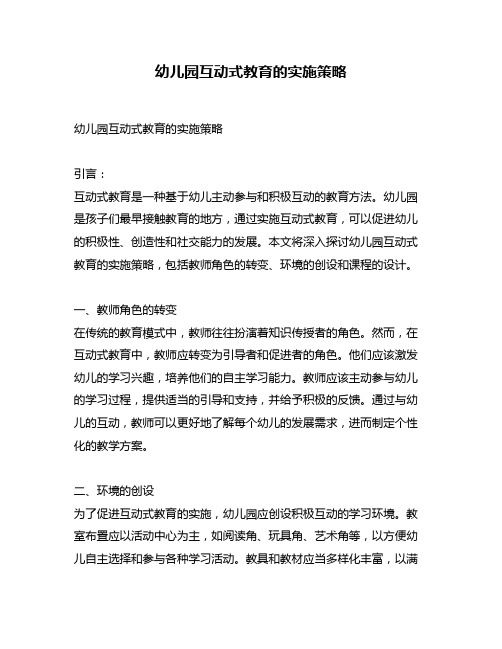
幼儿园互动式教育的实施策略幼儿园互动式教育的实施策略引言:互动式教育是一种基于幼儿主动参与和积极互动的教育方法。
幼儿园是孩子们最早接触教育的地方,通过实施互动式教育,可以促进幼儿的积极性、创造性和社交能力的发展。
本文将深入探讨幼儿园互动式教育的实施策略,包括教师角色的转变、环境的创设和课程的设计。
一、教师角色的转变在传统的教育模式中,教师往往扮演着知识传授者的角色。
然而,在互动式教育中,教师应转变为引导者和促进者的角色。
他们应该激发幼儿的学习兴趣,培养他们的自主学习能力。
教师应该主动参与幼儿的学习过程,提供适当的引导和支持,并给予积极的反馈。
通过与幼儿的互动,教师可以更好地了解每个幼儿的发展需求,进而制定个性化的教学方案。
二、环境的创设为了促进互动式教育的实施,幼儿园应创设积极互动的学习环境。
教室布置应以活动中心为主,如阅读角、玩具角、艺术角等,以方便幼儿自主选择和参与各种学习活动。
教具和教材应当多样化丰富,以满足幼儿多样化的学习需求。
通过利用团队游戏、角色扮演和科学实验等活动,鼓励幼儿进行合作学习和探索性学习。
教室的平面布局应合理规划,提供适合小组合作和互动交流的空间。
三、课程的设计互动式教育需要有科学合理的课程设计,以确保幼儿全面发展。
在设计课程时,可以遵循由浅入深、由易到难的原则,以帮助幼儿循序渐进地学习和掌握知识和技能。
鼓励幼儿通过实践和探索来构建自己的知识体系,而不是简单地接受教师的灌输。
在课堂上,教师可以采用小组活动、故事讲解、角色扮演等丰富多样的教学形式,激发幼儿的学习兴趣和创造力。
结论:幼儿园互动式教育的实施策略包括教师角色的转变、环境的创设和课程的设计。
通过将教师转变为引导者和促进者的角色,创设积极互动的学习环境,并设计富有创造性和有趣性的课程,可以促进幼儿的积极性、创造性和社交能力的发展。
幼儿园互动式教育不仅可以帮助幼儿建立良好的学习态度和学习习惯,还可以培养他们的自主学习能力,为他们未来的学习奠定坚实的基础。
英语五种教学策略
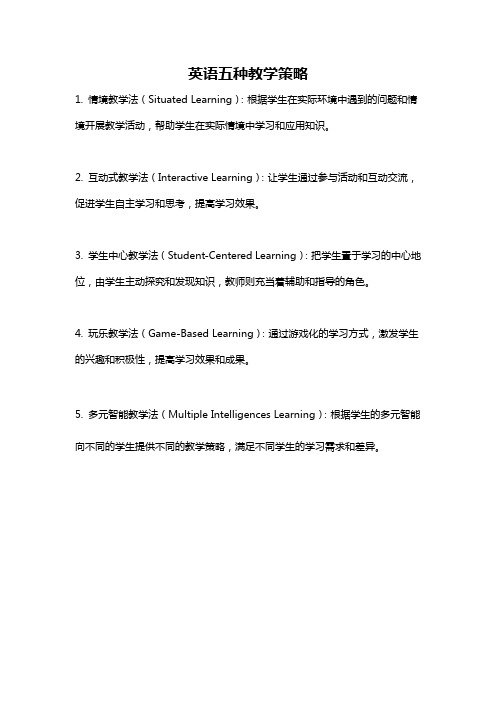
英语五种教学策略
1. 情境教学法(Situated Learning):根据学生在实际环境中遇到的问题和情境开展教学活动,帮助学生在实际情境中学习和应用知识。
2. 互动式教学法(Interactive Learning):让学生通过参与活动和互动交流,促进学生自主学习和思考,提高学习效果。
3. 学生中心教学法(Student-Centered Learning):把学生置于学习的中心地位,由学生主动探究和发现知识,教师则充当着辅助和指导的角色。
4. 玩乐教学法(Game-Based Learning):通过游戏化的学习方式,激发学生的兴趣和积极性,提高学习效果和成果。
5. 多元智能教学法(Multiple Intelligences Learning):根据学生的多元智能向不同的学生提供不同的教学策略,满足不同学生的学习需求和差异。
初中英语教学方法概述

初中英语教学方法概述在当前全球化的背景下,英语作为国际交流的通用语言,其重要性不言而喻。
在我国教育体系中,初中阶段是英语学习的关键时期,这一阶段的教学效果直接影响到学生未来的英语水平。
因此,探索初中英语教学方法,提高教学质量,对于培养学生的英语素养和综合运用能力具有重要意义。
本文将从以下几个方面对初中英语教学方法进行概述。
1. 直接法直接法(Direct Method)是一种以目标语言为唯一教学媒介的教学方法。
它主张教师用目标语言进行授课,避免使用母语,使学生在语言环境中自然习得语言。
直接法的核心思想是“实践先于解释”,教师通过实物、图片、动作等直观手段,让学生在实际语境中感知和理解英语。
这种教学方法有利于培养学生的语言表达能力,提高学生的听说能力。
2. 情景教学法情景教学法(Situation Teaching Method)是指教师在教学过程中,根据教材内容创设真实的语言环境,让学生在特定的情境中进行语言实践。
情景教学法强调学生的参与和体验,教师通过设定各种真实的场景,如购物、问路、聚会等,让学生在角色扮演、讨论、互动等活动中学习和使用英语。
这种教学方法有助于提高学生的语言运用能力,增强学生的学习兴趣。
3. 交际法交际法(Communicative Approach)是以培养学生的交际能力为核心的教学方法。
它强调在教学过程中,教师要引导学生进行真实的语言交流,让学生在实际的语言使用中学习和发展语言能力。
交际法教学注重学生的主体地位,教师的角色是组织者、引导者和促进者。
这种教学方法有助于提高学生的交际能力,培养学生的跨文化意识。
4. 任务型教学法任务型教学法(Task-Based Language Teaching)是指教师通过设计各种任务,让学生在完成任务的过程中学习和使用英语。
任务型教学法强调学习者的自主性、合作性和真实性,教师要为学生提供丰富的语言资源,营造真实的学习氛围。
学生在完成任务的过程中,不仅可以提高自己的语言能力,还能培养团队合作精神和解决问题的能力。
互动式教学法在初中英语教学中的运用

互动式教学法在初中英语教学中的运用Interactive Teaching Methods in Middle School English InstructionThe traditional lecture-based approach to education has long been the dominant model in classrooms around the world. In this method, the teacher serves as the primary source of information, delivering content to passive students who are expected to absorb and regurgitate the material. While this approach can be effective for imparting basic knowledge, it often fails to engage students or foster the critical thinking and problem-solving skills necessary for success in the 21st century. As a result, educators have increasingly turned to more interactive teaching methods that place the student at the center of the learning process.One such approach that has gained significant traction in recent years is interactive teaching. This pedagogical philosophy emphasizes the active participation of students in their own learning, with the teacher serving as a facilitator and guide rather than a sole provider of information. By incorporating a variety of interactive techniques, such as group discussions, hands-on activities, and collaborative projects, interactive teaching aims to create a more dynamic and engaging learning environment.In the context of middle school English instruction, the application of interactive teaching methods can be particularly beneficial. At this stage of their educational journey, many students are grappling with the complexities of a new language and the challenges of adolescence. By fostering a more interactive and student-centered approach, teachers can help to address these challenges and better support the academic and personal growth of their students.One key advantage of interactive teaching in middle school English is its ability to enhance student engagement and motivation. By actively involving students in the learning process, interactive methods can help to combat the disinterest and disengagement that often plague traditional lecture-based classrooms. Through activities that encourage discussion, problem-solving, and creative expression, students are more likely to remain attentive, participate actively, and develop a genuine enthusiasm for the subject matter.Moreover, interactive teaching can also support the development of critical thinking and language skills. By engaging students in tasks that require them to analyze, synthesize, and apply their knowledge, interactive methods can help to cultivate the higher-order cognitive abilities that are essential for success in English language learning. Additionally, the collaborative nature of many interactive activities can provide valuable opportunities for students to practice theircommunication and interpersonal skills, which are equally vital in the context of language acquisition.Another significant benefit of interactive teaching in middle school English is its ability to accommodate diverse learning styles and needs. Traditional lecture-based instruction often favors students who thrive in passive, auditory-based learning environments. In contrast, interactive teaching methods can cater to a wider range of learning preferences, including visual, kinesthetic, and collaborative learners. By incorporating a variety of interactive techniques, teachers can ensure that all students have the opportunity to engage with the material in a way that resonates with their individual learning needs and preferences.Furthermore, interactive teaching can also foster a more inclusive and supportive classroom environment. By encouraging students to actively participate, share their ideas, and work collaboratively, interactive methods can help to break down barriers and promote a sense of community within the classroom. This, in turn, can lead to increased feelings of belonging and confidence among students, which can have a positive impact on their academic performance and overall well-being.Of course, the successful implementation of interactive teaching in middle school English instruction requires careful planning andexecution on the part of the teacher. Educators must be well-versed in a range of interactive techniques and strategies, and they must be able to effectively integrate these methods into their overall instructional approach. Additionally, teachers must be prepared to navigate the challenges that can arise when transitioning from a more traditional, teacher-centered model to a more interactive, student-centered one.Despite these challenges, the potential benefits of interactive teaching in middle school English instruction are significant and well-documented. By fostering active engagement, critical thinking, and a supportive learning environment, interactive methods can help to unlock the full potential of students and prepare them for success both in the English language classroom and beyond.In conclusion, the application of interactive teaching methods in middle school English instruction represents a valuable and promising approach to language learning. By empowering students to take an active role in their own education, interactive teaching can help to cultivate the skills, knowledge, and dispositions necessary for lifelong success. As educators continue to explore and refine this pedagogical approach, the benefits of interactive teaching in middle school English are likely to become increasingly evident and widespread.。
i开头教学的英语
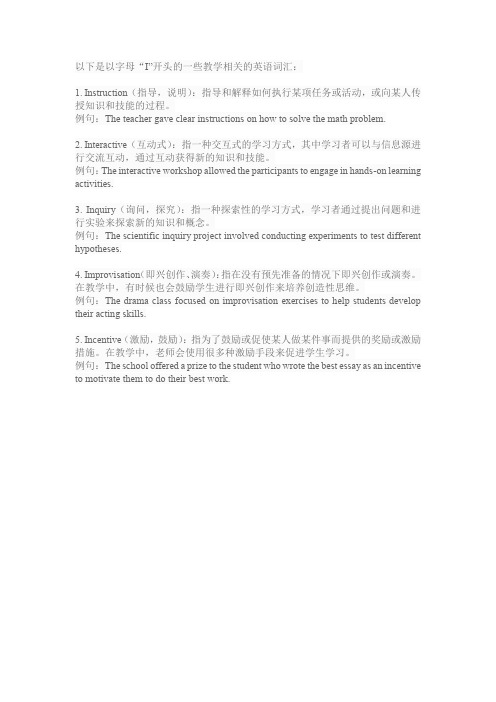
以下是以字母“I”开头的一些教学相关的英语词汇:1. Instruction(指导,说明):指导和解释如何执行某项任务或活动,或向某人传授知识和技能的过程。
例句:The teacher gave clear instructions on how to solve the math problem.2. Interactive(互动式):指一种交互式的学习方式,其中学习者可以与信息源进行交流互动,通过互动获得新的知识和技能。
例句:The interactive workshop allowed the participants to engage in hands-on learning activities.3. Inquiry(询问,探究):指一种探索性的学习方式,学习者通过提出问题和进行实验来探索新的知识和概念。
例句:The scientific inquiry project involved conducting experiments to test different hypotheses.4. Improvisation(即兴创作、演奏):指在没有预先准备的情况下即兴创作或演奏。
在教学中,有时候也会鼓励学生进行即兴创作来培养创造性思维。
例句:The drama class focused on improvisation exercises to help students develop their acting skills.5. Incentive(激励,鼓励):指为了鼓励或促使某人做某件事而提供的奖励或激励措施。
在教学中,老师会使用很多种激励手段来促进学生学习。
例句:The school offered a prize to the student who wrote the best essay as an incentive to motivate them to do their best work.。
- 1、下载文档前请自行甄别文档内容的完整性,平台不提供额外的编辑、内容补充、找答案等附加服务。
- 2、"仅部分预览"的文档,不可在线预览部分如存在完整性等问题,可反馈申请退款(可完整预览的文档不适用该条件!)。
- 3、如文档侵犯您的权益,请联系客服反馈,我们会尽快为您处理(人工客服工作时间:9:00-18:30)。
By the end of this session, you should be able to…
• build up connections between interactive teaching and student learning
• plan a lesson using interactive teaching approach • be aware of possible tools/strategies and choose appropriate ones to achieve designated learning outcomes
References
• Morris, G. (2011). Exploring Interactive Learning. (Certificate Stage 1 course PPT). CETL, HKU.
• Biggs, J. & Tang, C. (2011) Teaching for quality learning at university: What the student does. Maidenhead: McGraw-Hill/Society for Research into Higher Education/Open University Press, 2011. • Bligh, D. A. (1972). What’s the use of lectures? Harmondsworth: Penguin. • Lyman, F. (1987). Think-Pair-Share: An expanding teaching technique. MAA-CIE Cooperative News, v. 1, p. 1–2
1. Reflect on one thing you learnt most effectively or you
are good at.
How did you learn/do it? Write
down your experience. [1 min]
2. Pair up with a colleague and Share your reflections. [2
What do we expect our students to be able to do or demonstrate as a result of the learning?
Content
What specific knowledge, skills and attitude do they need to learn to achieve the outcomes?
A.
B. C.
D.
E.
So that lecturers can demonstrate how expert they are in their subject. Because they are a very efficient means of transmitting information to large numbers of students. In order to provide a common space where students can be enthused by a lecturer exploring key concepts of their subject. Because students expect them as part of university (rather than school) education and prefer listening to having to contribute themselves. Because lectures are easier to prepare than more interactive resource-based techniques such as case study discussions or problem-based tutorials.
Use of gห้องสมุดไป่ตู้od questioning
– – –
Generate and stimulate discussion Clarify, e.g.. What do you mean by…?; Are you saying that….? Probe, e.g.' Why would you argue…?; ‘What might be an example of X?
AL2 – Group MCQ with Response Cards
Think [write]-pair-share
a process that first, asks students to consider a response individually, then to a form a pair. Each pair discusses their various responses. Then pairs are invited to join with another pair to share. You may ask the larger groups to contribute one idea or response at the conclusion of the activity. Writing can be helpful in getting students to commit to their ideas or answer
(Lyman, 1987)
Questioning
• Convergent questions
– with a correct answer in mind – students are steered towards that answer
• Divergent questions
– open-ended – constructing fresh ideas and interpretations – functioning knowledge
mins]
3. Be prepared to bring forward any
reflections/observations for the larger group.
Adults’ attention span
(Bligh, 1972)
Outcomes-based Approach
Intended outcomes
–
– –
Refocus or redirect
Give you a sense of students’ understanding, Motivate students through timely feedback
To sum up…
Be aware of how you’re using activity, and be able to direct the students’ experience to focus their learning Activities/material need to connect with content in meaningful way Model early - 1st class provide structured opportunity to interact with each other and you Activities need to be controlled, highly disciplined – clear instructions, time parameters and explicit expectations If ‘new’ to active learning within your classes – start early, start small [might just be looking at actual presentation] and build up incrementally as comfort/confidence grows
In the next practice session…
• you will lead a 15-minute tutorial session • it should be interactive
• still with no PPT
• you don’t have to submit a teaching plan.
listen Take notes Understand (correctly? Deeply enough?) Watch, note points Write answers to questions Possibly ask a question
(Biggs & Tang, 2011)
Pick the best answer Why are lectures still used so frequently in higher education?
Teaching & Learning
What are the most appropriate teaching and learning methods for helping students to achieve the outcomes?
Assessment
What methods of assessment are most suitable for measuring students’ attainment of the outcomes?
Learning outcomes: “Explain” a theory/ concept
Teacher activity
